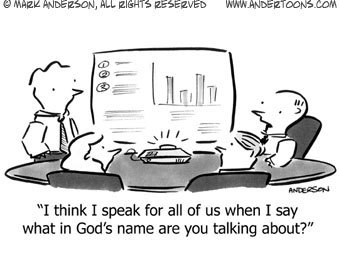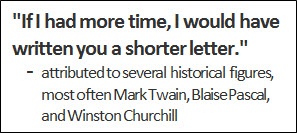You’re standing in front of the conference room.  The people at the table are listening, mostly. Sometimes they glance at their phones or sip at their coffee. You’re here to make a vendor recommendation. Get this right, and you’ll have the budget for that long overdue HR initiative. Get this “not quite right,” and they’ll thank you for your thoughts and promise to “keep this as an option for further consideration moving forward.”
The people at the table are listening, mostly. Sometimes they glance at their phones or sip at their coffee. You’re here to make a vendor recommendation. Get this right, and you’ll have the budget for that long overdue HR initiative. Get this “not quite right,” and they’ll thank you for your thoughts and promise to “keep this as an option for further consideration moving forward.”
So you go through your process and options. Forty minutes later, you conclude. The VP of HR asks some questions. The CIO asks some more detailed questions. All agree that this is definitely something to consider in the future.
Verdict: not quite right. You have a lot more convincing to do, and until then your plan stays on the shelf. What really happened? It’s likely that your details drowned out your point and you lost your audience.
If someone ever tells you that they’ve never lost an audience of decision makers when making a recommendation, they’ve either never tried or they’re lying. Fortunately, experience is a terrific teacher. It drives home one overriding lesson, whether your recommendations come through a presentation, on paper, in an email or through a one-on-one conversation: Keep it Simple Stupid (KISS).
Everyone knows about KISS, and yet ignoring the rule remains one of the biggest killers of otherwise sound strategies today. Knowing isn’t enough. A better plan is to create your message and test it against a solid KISS checklist, every time. This takes some extra time and effort, but it can mean the difference between real leadership support and another case of clouds in your coffee.
Presentation, Conversation, Email: How to Re-visit the KISS Rules
 Whether you are sending the document for review or presenting to leadership, the key is to keep it concise. Here are the steps:
Whether you are sending the document for review or presenting to leadership, the key is to keep it concise. Here are the steps:
- Establish Your Point, the Goals and Context: Set these early on. It’s the real agenda. This allows participants to get a feel for how the information is going to be provided.
- Give the background. This is your opportunity to get the decision-makers on the same page. Use as much detail as necessary, but don’t go overboard. Make sure that your audience understands why you are looking for them to make a decision.
- Introduce the vendors / products / solutions. Again, not too much detail, but a brief overview of each vendor / player in the decision and why they were included. You may also need to briefly touch on the vendors that weren’t included and why.
- Describe the process. This is all about credibility. The purpose is to instill confidence that your evaluation was methodical and that the decision was a thoughtful one. Describe at a high-level the steps that were taken. No need to educate your audience in too much detail.
- Provide the details. Now you want to show the strengths and gaps of the possible options or alternatives. Show the important strengths and gaps in a side-by-side comparison that will allow the decision-makers to see what the critical factors were. These two sections may lead to a significant amount of discussion as the decision-makers may want some understanding of why some items were considered more significant in the decision than others.
- Finally, show the recommendation. Be sure to express why that is the recommendation and what the results of that selection will be. At times the recommendation may not always be the most obvious, and if that is the case, be sure to have your talking points ready to ensure that the decision-makers have an understanding of the selection. If you are presenting this in a document or presentation, and you feel you want to have additional information at the ready, include an appendix with the details that you can refer to if the questions come up.
Remember that your audience should be getting a short summary of your overall selection process. Don’t inundate them with details, but make sure you can prove you are giving them an informed recommendation. Keep your additional information in reserve in case you are pressed to provide, but short and simple is the way to go.


